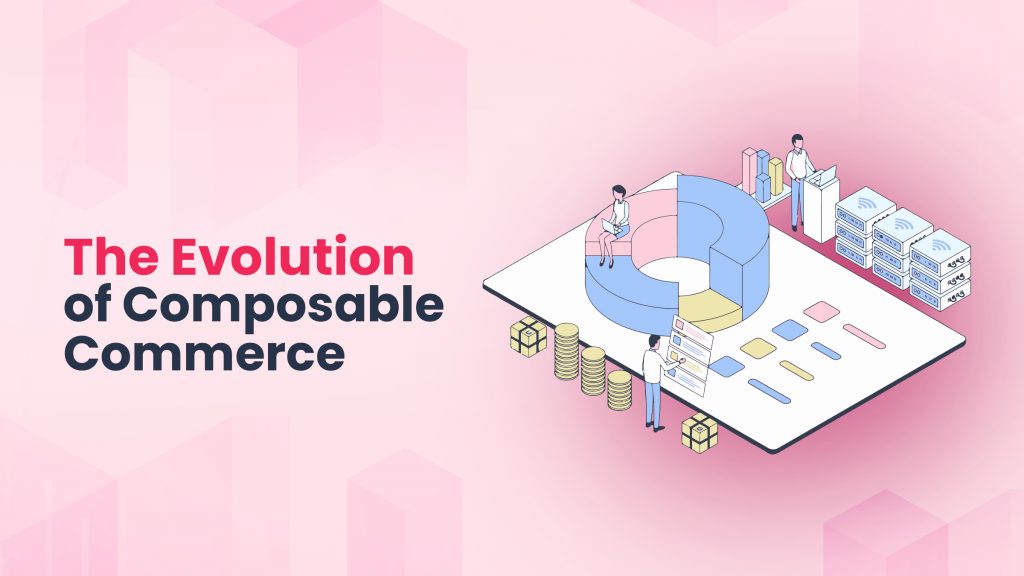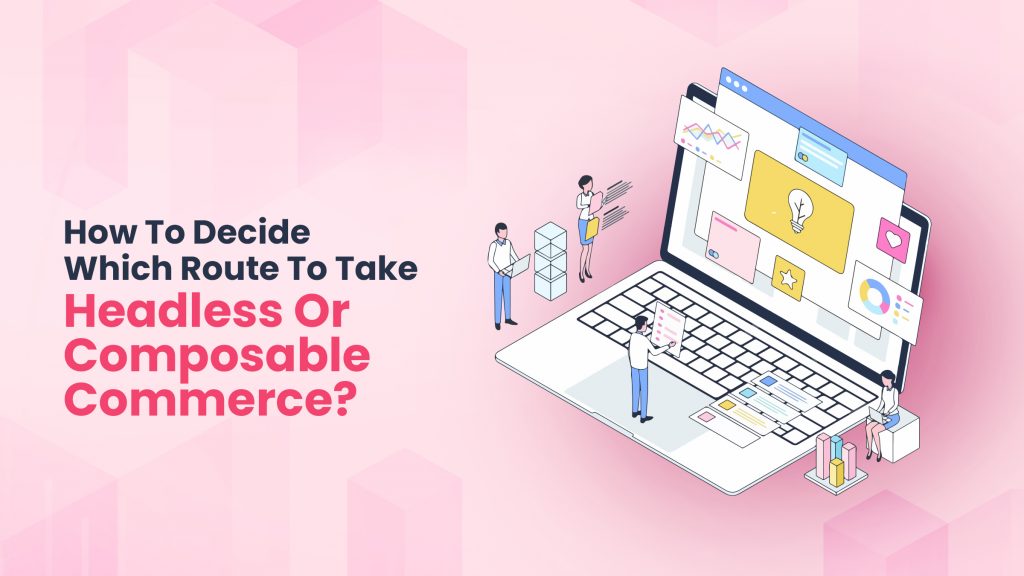
Composable commerce is all the rage nowadays, and it’s not just a passing trend. This innovative approach is poised to redefine how we do e-commerce, possibly for good.
In the ever-changing digital commerce landscape, buzzwords come and go. But composable commerce isn’t just another fleeting fad. The service-oriented approach isn’t new but reaches new heights when paired with MACH architecture’s core principles.
What is Composable Commerce?
Composable commerce is a modern approach to e-commerce architecture that emphasises flexibility, agility, and modularity. Unlike traditional monolithic systems & breaks down functionality into smaller, independent components.
“Composable building blocks,” can be easily assembled and orchestrated to create tailored commerce experiences that meet specific business needs.
Real Life Example
For instance, a well-known UK-based business that has adopted composable commerce principles is ASOS, an online fashion and beauty retailer. In addition to product management, inventory tracking, and payment processing, ASOS has a highly modular architecture utilizing microservices. By embracing composable commerce, ASOS can swiftly adapt to changing fashion trends. Furthermore, it offers personalised shopping experiences and efficiently scales its platform to meet growing demand.
UK-based businesses like AO.com and Made.com use composable commerce strategies to improve their e-commerce capabilities.
Composable commerce principles help businesses stay competitive in the digital marketplace.
The Evolution of Composable Commerce
Think of composable commerce as the evolution of how we build software systems. It’s like moving from constructing a single, massive building to assembling a collection of modular, interchangeable components.
Consider a traditional software application as a monolithic structure – all the code tightly bundled together, making it difficult to modify or scale. Imagine breaking down this monolith into smaller, independent services, each responsible for a specific function. These services, known as microservices, act like individual building blocks that can be assembled and rearranged to create custom solutions tailored to specific business needs.
This approach draws heavily from the success of microservices architecture, which has revolutionised software development by enabling greater scalability, resilience, and innovation. Microservices allow developers to focus on building smaller, more manageable units of code, which can then be easily combined to create complex systems.

Instead of just breaking down the backend infrastructure into microservices, it extends modularity to every aspect of the e-commerce ecosystem – from frontend interfaces to third-party integrations.
For instance, imagine an online retailer that wants to add a new payment gateway to its checkout process. With a composable commerce approach, the retailer can simply plug in a pre-built payment microservice, rather than having to rewrite the entire checkout system. This modularity not only streamlines development but also enhances agility, allowing businesses to adapt quickly to changing market conditions and customer demands.
In summary, Ecommerce builds upon the principles of modularisation and decoupling within software development, leveraging microservices architecture to create flexible, adaptable e-commerce solutions. By breaking down complex systems into smaller, interchangeable components, businesses can achieve greater scalability, resilience, and innovation in the ever-evolving digital landscape.
What are the benefits of composable commerce?
- Flexibility: Composable architecture enables businesses to swiftly adapt to changing market conditions and customer preferences.
- Scalability: Breaking down monolithic systems into smaller, reusable components allows for seamless scalability without compromising performance. Example: A retail website experiences a surge in traffic during a holiday sale.
- Innovation: Composable architecture fosters innovation by empowering developers to experiment, iterate, and deploy new features independently. Example: A software company utilising commerce continuously releases new features and updates to its e-commerce platform, such as AI-driven product recommendations or chatbot customer support, enhancing the overall customer experience.
- Personalisation: Businesses can create highly personalised customer experiences by assembling tailored solutions from a variety of best-of-breed components.
- Cost Efficiency: Leveraging modular components and cloud-based services, commerce helps reduce development costs and time-to-market. Example: A startup launching an e-commerce platform utilises composable commerce to access pre-built microservices for essential functionalities like user authentication, payment processing, and inventory management, reducing development time and infrastructure costs.
In summary, composable commerce offers businesses in the UK the flexibility to adapt, scale, innovate, personalise, and operate cost-effectively in the dynamic digital marketplace, ultimately driving growth and customer satisfaction.
Challenges of composable commerce
1. Integration Complexity:
- E-commerce involves integrating various independent components, which can lead to complexity in managing these integrations effectively.
- Imagine composable commerce as building a puzzle with pieces from different sets. Ensuring that each piece fits seamlessly together requires careful coordination and planning.
- To overcome integration complexity, businesses need robust API management and integration tools. These tools help streamline communication between different components and ensure smooth interoperability.
2. Governance and Control:
- Think of E-commerce as a bustling marketplace with vendors offering various products. Managing this marketplace requires effective governance mechanisms to maintain order and reliability.
- For instance, an e-commerce platform may implement strict access controls, encryption protocols, and auditing mechanisms to safeguard customer data and ensure compliance with regulations like GDPR (General Data Protection Regulation).
3. Talent and Skills:
- Adopting composable commerce may require businesses to upskill their existing teams or hire new talent with expertise in microservices architecture and cloud-native technologies.
- Consider E-commerce as embarking on a journey to explore new territories. To navigate these uncharted waters, businesses need skilled guides who understand the terrain.
- Upskilling existing teams involves providing training and resources to familiarise them with microservices architecture, containerisation, orchestration platforms, and cloud-native technologies.
- For example, an e-commerce company may invest in training programmes, certifications, and workshops to empower its development teams with the necessary skills and knowledge to succeed in the composable commerce landscape.
How to get started with composable commerce?

Assess your current architecture
- Evaluate your existing e-commerce architecture to identify areas where E-commerce principles can add value.
- Determine which functionalities or processes could benefit from modularity, scalability, or flexibility.
- For example, assess whether your current system struggles with scalability during peak traffic periods or lacks flexibility in adapting to new features or integrations.
Invest in foundational technologies
- Invest in foundational technologies that support composable commerce, such as API management, containerisation, and orchestration platforms.
- Ensure that your infrastructure can effectively manage and orchestrate microservices, enabling seamless integration and communication between components.
- Consider deploying containerisation technologies like Docker or Kubernetes to containerise and manage your microservices efficiently.
Adopt an incremental approach
- Start with pilot projects or proof-of-concepts to validate the feasibility and benefits of composable commerce in your organisation.
- Choose a specific area or functionality within your e-commerce ecosystem to experiment with principles.
- Break down the chosen functionality into smaller, modular components and implement them using architecture principles.
- Monitor the performance, scalability, and agility of your pilot project to assess its effectiveness and identify areas for improvement.
Foster a culture of collaboration and experimentation
- Encourage collaboration and knowledge sharing among your development teams to foster a culture of innovation and experimentation.
- Provide resources, training, and support to help teams explore new ideas and approaches to composable commerce.
- Establish feedback loops and mechanisms for continuous improvement to iteratively refine your composable architecture based on lessons learned from pilot projects.
- Celebrate successes and learn from failures to drive continuous innovation and evolution in your approach to E-commerce.
- By following these steps, you can lay the groundwork for implementing E-commerce in your organisation and unlock the benefits of modularity, scalability, and innovation in your e-commerce ecosystem.
How is Composable Commerce Changing Commerce Experiences?
Composable commerce is revolutionising commerce experiences in several ways:
1. Hyper-Personalisation:
- Businesses can now deliver hyper-personalised experiences by crafting tailored solutions that cater to individual customer preferences and behaviours.
- Imagine walking into a store where everything from product recommendations to marketing messages feels specifically designed for you, based on your past interactions and preferences.
2. Rapid Innovation:
- E-commerce architecture fosters a culture of rapid innovation by allowing businesses to experiment and deploy new features and services quickly.
- Think of it as a fast-paced innovation lab where ideas can be tested, refined, and launched into the market at lightning speed, keeping businesses ahead of the curve.
3. Seamless Omnichannel Experiences:
- Composable commerce empowers businesses to provide seamless omnichannel experiences by integrating various systems and touchpoints.
- Picture a scenario where your online shopping journey seamlessly transitions from a website to a mobile app to a physical store, with consistent branding, product availability, and pricing across all channels.
4. Enhanced Agility:
- By decoupling components and embracing cloud-native technologies, businesses become more agile and responsive to market changes and customer demands.
- Think of it as a business that can adapt and pivot effortlessly, like a nimble athlete, in response to shifting market dynamics, emerging trends, and evolving consumer behaviours.
In summary, E-commerce is driving a paradigm shift in commerce experiences, enabling businesses to deliver highly personalised, innovative, and seamlessly integrated experiences while maintaining agility and responsiveness in a rapidly changing digital landscape.
How to Decide Which Route to Take – Headless or Composable Commerce?

Choosing between headless and composable commerce depends on factors such as business goals, technical capabilities, and existing infrastructure:
- Headless Commerce: Headless commerce decouples the front-end presentation layer from the back-end commerce engine, providing flexibility and agility in designing customer experiences.
- E-commerce takes the modular approach a step further by breaking down the entire commerce stack into reusable components, offering greater flexibility and customisation options.
If You’re Struggling to Decide: If you’re unsure about which approach is best for your business, RVS Media can assist you with your complete digital transformation needs. Whether you opt for headless or composable commerce, we can help you navigate the process and implement the solution that aligns with your goals and requirements.
Conclusion:
Composable commerce represents a paradigm shift in e-commerce architecture, offering businesses the flexibility, agility, and innovation needed to thrive in today’s digital economy. By embracing the principles and leveraging modular architecture, businesses can create highly personalised, scalable, and resilient commerce experiences that drive growth and customer loyalty. As the e-commerce landscape continues to evolve, composable commerce promises to be a transformative force, shaping the future of commerce for years to come.
 Shopify
Shopify




















